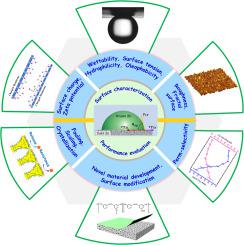Advances in Colloid and Interface Science ( IF 15.6 ) Pub Date : 2021-09-24 , DOI: 10.1016/j.cis.2021.102524 Md Farhad Ismail 1 , Muhammad Amirul Islam 2 , Behnam Khorshidi 3 , Ali Tehrani-Bagha 4 , Mohtada Sadrzadeh 2

|
Thin-film composite (TFC) membranes are the most widely used membranes for low-cost and energy-efficient water desalination processes. Proper control over the three influential surface parameters, namely wettability, roughness, and surface charge, is vital in optimizing the TFC membrane surface and permeation properties. More specifically, the surface properties of TFC membranes are often tailored by incorporating novel special wettability materials to increase hydropHilicity and tune surface physicochemical heterogeneity. These essential parameters affect the membrane permeability and antifouling properties. The employed membrane surface characterization protocols to date are rather controversial, and there is no general agreement about the metrics used to evaluate the surface hydrophilicity and physicochemical heterogeneity. In this review, we survey and critically evaluate the process that emerged for understanding the membrane surface properties using the simple and economical contact angle analysis technique. Contact angle analysis allows the estimation of surface wettability, surface free energy, surface charge, oleophobicity, contact angle hysteresis, and free energy of interaction; all coordinatively influence the membrane permeation and fouling properties. This review will provide insights into simplifying the evaluation of membrane properties by contact angle analysis that will ultimately expedite the membrane development process by reducing the time and expenses required for the characterization to confirm the success and the impact of any modification.
中文翻译:

使用接触角技术对薄膜复合膜进行表面表征:量化策略和应用综述
薄膜复合 (TFC) 膜是低成本和节能型海水淡化过程中使用最广泛的膜。适当控制三个有影响的表面参数,即润湿性、粗糙度和表面电荷,对于优化 TFC 膜表面和渗透性能至关重要。更具体地说,TFC 膜的表面特性通常是通过加入新的特殊润湿性材料来定制的,以增加亲水性和调整表面物理化学异质性。这些基本参数影响膜渗透性和防污性能。迄今为止采用的膜表面表征协议颇有争议,并且对于用于评估表面亲水性和物理化学异质性的指标没有普遍共识。在这次审查中,我们使用简单经济的接触角分析技术调查并批判性地评估了为了解膜表面特性而出现的过程。接触角分析允许估计表面润湿性、表面自由能、表面电荷、疏油性、接触角滞后和相互作用的自由能;所有这些都协同影响膜的渗透和污染特性。该评论将提供有关通过接触角分析简化膜性能评估的见解,最终将通过减少表征所需的时间和费用来加快膜开发过程,以确认任何修改的成功和影响。



























 京公网安备 11010802027423号
京公网安备 11010802027423号